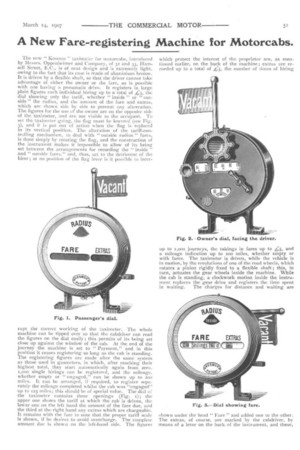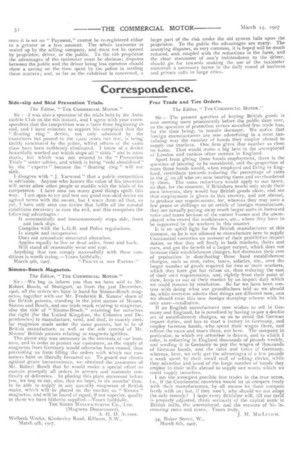A New Fare-registering Machine for Motorcabs.
Page 51

Page 52

If you've noticed an error in this article please click here to report it so we can fix it.
The new " Kosmos " taximeter for motorcabs, introduced by Messrs. Oppenheimer and Company, of 32 and 33, Hamsell Street, E.C., is of neat design and is extremely light, owing to the fact that its case is made of aluminium bronze. It is driven by a flexible shaft, so that the driver cannot take advantage of either the owner or the fare, as is possible with one having a pneumatic drive. It registers in large plain figures each individual hiring up to a total of the dial showing only the tariff, whether "inside " or " outside " the radius, and the amount of the fare and extras, which are shown side by side to prevent any altercation. The figures for the use of the owner are on the opposite side of the taximeter, and are not visible to the occupant. To set the taximeter going, the flag must be lowered (see Fig. 3), and it is put out of action when the flag is replaced in its vertical position. The alteration of the tariff-controlling mechanism, to deal with " outside radius " fares, is done simply by rotating the flag, and the construction of the instrument makes it impossible to allow of its being set between the arrangements for recording the " inside " and " outside fares," and, thus, act to the detriment of the hirer ; at no position of the flag lever is it possible to inter
rupt the correct working of the taximeter. The whole machine can be tipped over so that the cabdriver can read the figures on the dial easily ; this permits of its being set close up against the window of the cab. At the end of the journey the machine is set to " Payment," and in this position it ceases registering so long as the cab is standing. The registering figures are made after the same system as those used in gasmeters, in which, after reaching their highest total, they start automatically again front zero. 1,000 single hirings can be registered, and the mileage, whether empty or " engaged," can be shown up to 200 miles. It can be arranged, if required, to register separately the mileage completed whilst the cab was "engaged" up to 125 miles; this should be of special value. The dial of the taximeter contains three openings (Fig. t); the upper one shows the tariff at which the cab is driven, the lower one on the left hand the amount of the fare due, and the third at the right hand any extras which are chargeable. It remains with the fare to note that the proper tariff scale is shown, if he desires to avoid overcharge. The complete amount due is shown on the left-hand side. The figures.
which protect the interest of the proprietor are, as men• tioned earlier, on the back of the machine ; extras are recorded up to a total of 4:5, the number of times of hiring
up to 1,000 journeys, the takings in fares up to 45, and a mileage indication up to zoo miles, whether empty or with fares. The taximeter is driven, while the vehicle is in n-totion, by the revolutions of one of the road wheels, which rotates a pinion rigidly fixed to a flexible shaft ; this, in turn, actuates the gear wheels inside the machine. While the cab is standing, a clockwork motion inside the instrument replaces the gear drive and registers the time spent
in waiting. The charges for distance and waiting are shown under the head " Fare" and added one to the other. The extras, of course, are marked by the cabdriver, by means of a lever on the back of the instrument, and these, once ii is set on " Payment," cannot be re-registered either to a greater or a less amount. The whole taximeter is sealed up by the selling company, and must not be opened by proprietor, driver, or the public. To the cab proprietor the advantages of the taximeter must be obvious ; disputes between the public and the driver being less common should show a saving on the time spent by the police in settling these matters; and, as far as the cabdriver is concerned, a large part of the risk under the old system falls upon the proprietor. To the public the advantages are many. The annoying disputes, so very common, it is hoped will be much reduced, and, coupled with the reductions in the fares, and the clear statement of one's indebtedness to the driver, should go far towards making the use of the taxinaeter motorcab a necessary factor in the daily round of business and private calls in large cities.
































































